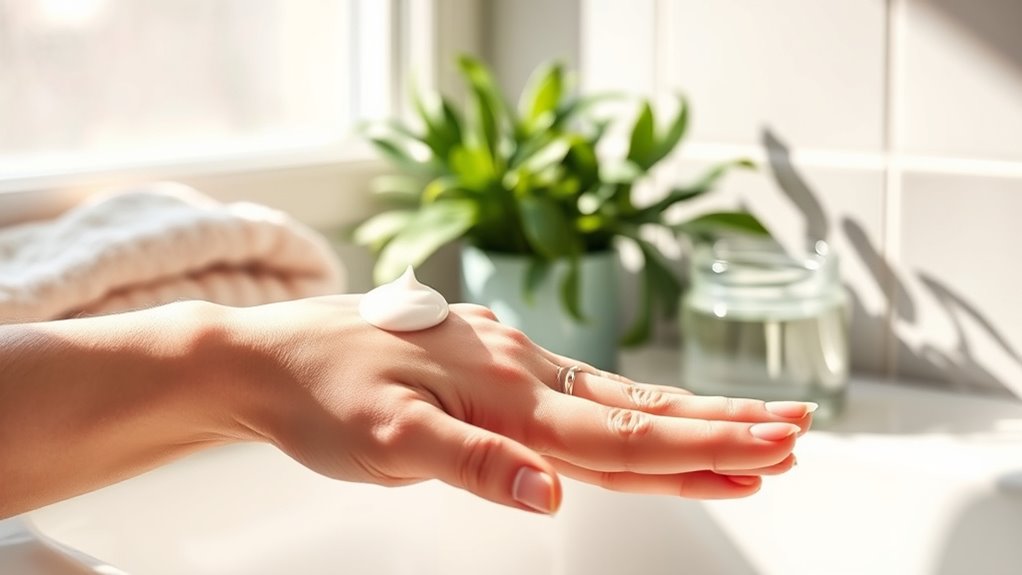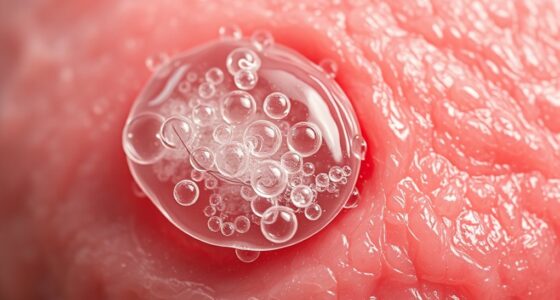Post-patch care is essential for keeping your skin healthy and happy. Start with gentle cleansing using a mild cleanser, and keep the area moisturized to promote healing. Don’t forget to apply a broad-spectrum sunscreen daily to protect against UV damage. Stay hydrated and incorporate skin-friendly foods into your diet for best recovery. Avoid irritants and monitor any skin reactions closely. There’s so much more to discover about enhancing your post-patch skincare routine.
Key Takeaways
- Gently cleanse the treated area with a mild, non-comedogenic cleanser to prevent irritation and infection.
- Apply a fragrance-free moisturizer to maintain hydration and support skin healing.
- Use broad-spectrum sunscreen with SPF 30 daily to protect sensitive skin from UV damage.
- Avoid harsh products and activities that can irritate the skin during the recovery process.
- Monitor skin reactions and consult a dermatologist for any adverse effects or concerns.
The Importance of Post-Patch Care
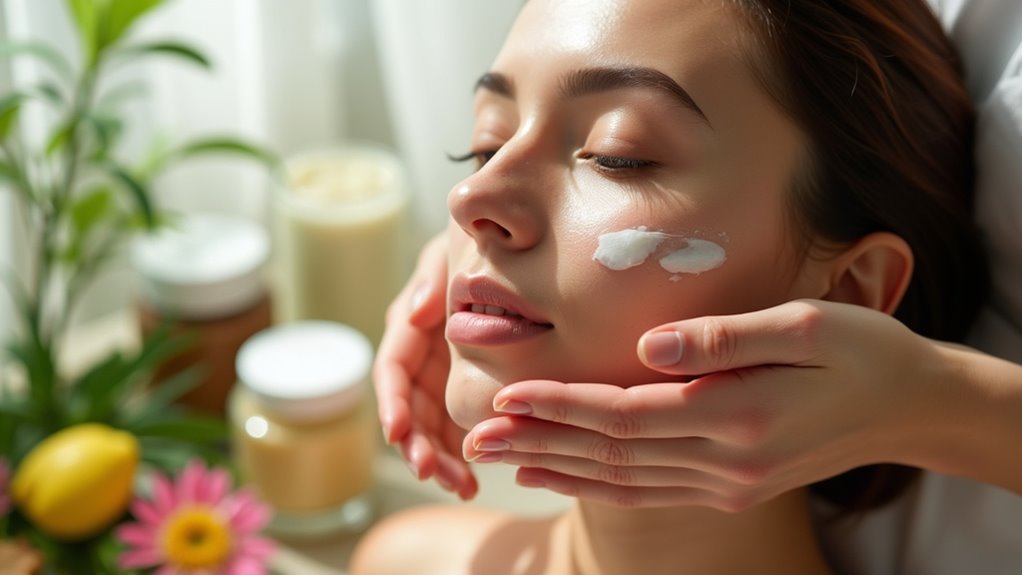
When you use a pimple patch, the importance of post-patch care can’t be overstated. Taking care of your skin after removing the patch is crucial for maintaining its integrity and preventing irritation or breakouts in the treated area.
Gentle cleansing and moisturizing promote healing, minimizing the risk of scarring or hyperpigmentation. Applying a soothing toner can also help restore your skin’s pH balance and reduce redness.
Don’t forget to consistently use sunscreen afterward; it protects your sensitive skin from UV damage, which can hinder recovery and worsen discoloration.
Plus, keep an eye on how your skin reacts to products, adjusting your routine as needed for effective care and long-term skin health. Protecting your skin now pays off later!
Immediate Aftercare Steps
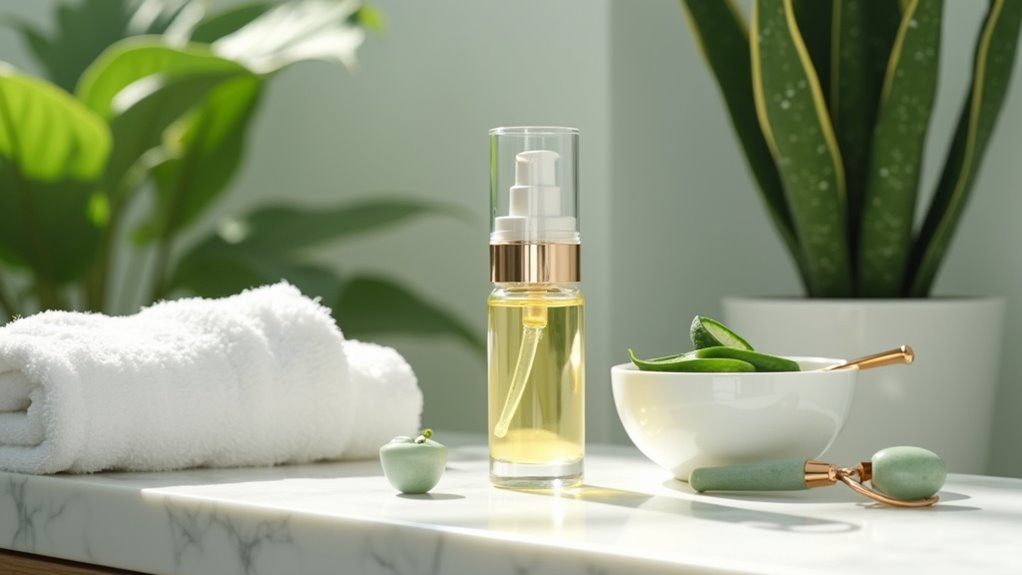
To guarantee your skin heals effectively after using a pimple patch, start by gently cleansing the area with a mild, non-comedogenic cleanser to remove any residue.
Ensure effective healing after using a pimple patch by gently cleansing the area with a mild, non-comedogenic cleanser.
Follow these immediate aftercare steps:
- Avoid touching or picking at the treated area to prevent infection and encourage healing.
- Apply a gentle, fragrance-free moisturizer to keep your skin hydrated and support recovery.
- Use cold compresses on the area for a few minutes to reduce any swelling that may occur post-application.
- Always follow any specific post-treatment instructions given by your skincare professional to ensure effective recovery.
Sun Protection Strategies

To protect your skin after treatment, daily sunscreen application is essential.
Choose a broad-spectrum sunscreen with at least SPF 30 and reapply it every two hours when you’re outside.
Additionally, wearing protective clothing like wide-brimmed hats can help shield your skin from harmful UV rays.
Daily Sunscreen Application
Protecting your skin with daily sunscreen application is essential, especially after any treatments that may leave it sensitive.
To guarantee your skin remains happy and healthy, follow these sun protection strategies:
- Choose a broad-spectrum sunscreen with an SPF of 30 or higher to guard against harmful UV exposure.
- Reapply sunscreen every two hours, especially when outdoors, to maintain effective protection throughout the day.
- Opt for physical sunblocks with zinc oxide or titanium dioxide, as they’re gentler on sensitive skin compared to chemical options.
- Incorporate sunscreen into your daily skin care routine, even on cloudy days or indoors, to protect against incidental UV exposure.
Additionally, remember that regular skin treatments can enhance your skin’s resilience against sun damage.
Protective Clothing Choices
While daily sunscreen application is essential for skin health, the right clothing choices can provide an additional layer of protection against harmful UV rays.
Opt for protective clothing like long-sleeved shirts and wide-brimmed hats to shield your skin from direct sun exposure. Look for fabrics with a UPF rating of 30 or higher, which block up to 97% of UV radiation.
Light-colored clothing reflects sunlight, keeping you cooler, while darker shades offer better UV protection. Tightly woven fabrics, such as denim or canvas, enhance your skin care routine by preventing UV rays from penetrating.
Whenever you’re outdoors, seek shade during peak sun hours (10 AM – 4 PM) to minimize direct exposure and keep your skin happy and healthy.
Hydration and Nutrition for Skin Health

Hydration and nutrition play crucial roles in maintaining healthy skin, so drinking at least eight glasses of water daily is necessary for keeping your skin elastic and radiant.
Hydration and nutrition are vital for healthy, radiant skin—aim for at least eight glasses of water daily.
To promote glowing skin, consider these tips:
- Incorporate anti-inflammatory foods: Add berries, fatty fish, and leafy greens to your diet to reduce redness and irritation.
- Focus on vitamins: Make sure your meals are rich in vitamins A, C, and E, along with minerals like zinc to support skin repair.
- Limit alcohol and caffeine: Reducing these can prevent dehydration that negatively affects your skin’s appearance.
- Consider supplements: Omega-3 fatty acids can enhance skin barrier function and provide anti-inflammatory benefits for clearer skin. Additionally, including chia seeds in your diet can boost your omega-3 intake and improve overall skin health.
Stay hydrated and nourish your skin to keep it looking its best!
Avoiding Irritants During Recovery
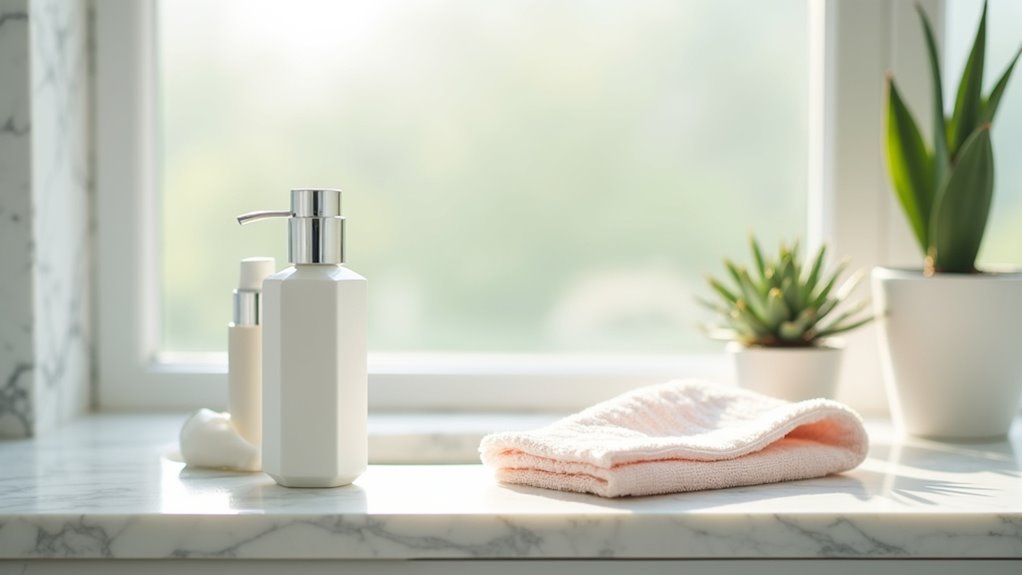
To guarantee a smooth recovery after your skin treatment, it’s essential to avoid irritants that could hinder healing. Stick to gentle skincare products and skip harsh exfoliants or alcohol-based toners. For the first few days, avoid hot water and steam to reduce inflammation. Refrain from makeup on the treated area until your skincare provider gives the green light. Limit activities that cause excessive sweating; this includes intense workouts and saunas, as perspiration can worsen irritation during the healing process. Finally, steer clear of swimming pools and hot tubs until you’re fully healed to minimize infection risks.
| What to Avoid | Why to Avoid It | Alternatives |
|---|---|---|
| Harsh skincare products | Can irritate and prolong healing | Gentle cleansers |
| Hot water and steam | Increases inflammation | Cool showers |
| Makeup | Impedes skin recovery | None until cleared |
Monitoring the Healing Process
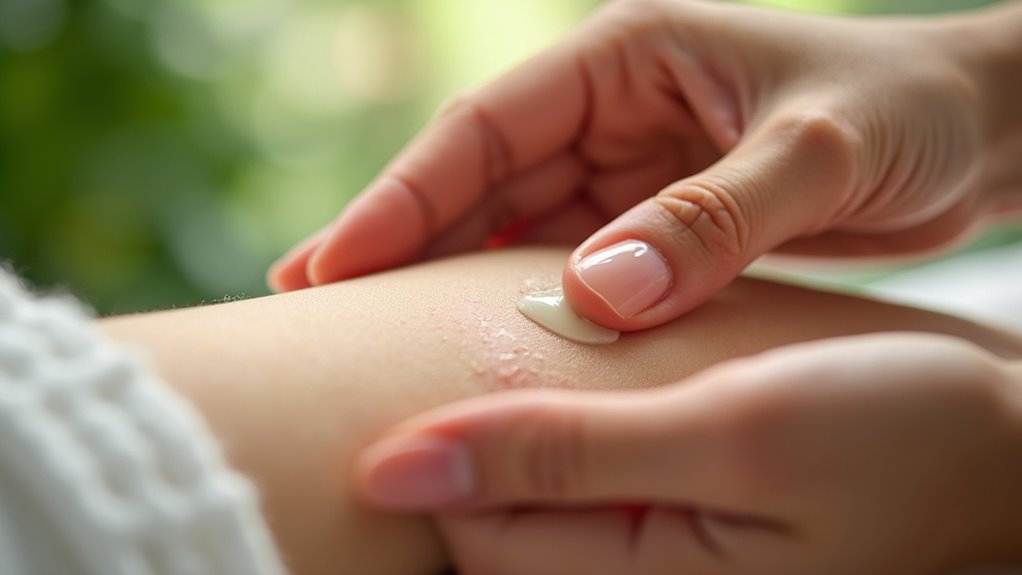
As you navigate your recovery, keeping an eye on your skin’s healing process is crucial. Monitoring your skin closely can help guarantee ideal results.
Here are some key points to reflect on:
- Watch for signs of infection: Increased redness, swelling, or pus can signal an issue, especially in the first few days.
- Note any unusual changes: Persistent itching or discomfort might indicate an adverse reaction.
- Document your healing progress: Keeping a daily log helps track improvements or setbacks, providing valuable information for your skincare provider.
- Seek professional advice if needed: If redness or irritation lingers, think about consulting a dermatologist for guidance.
Enhancing Your Skincare Routine
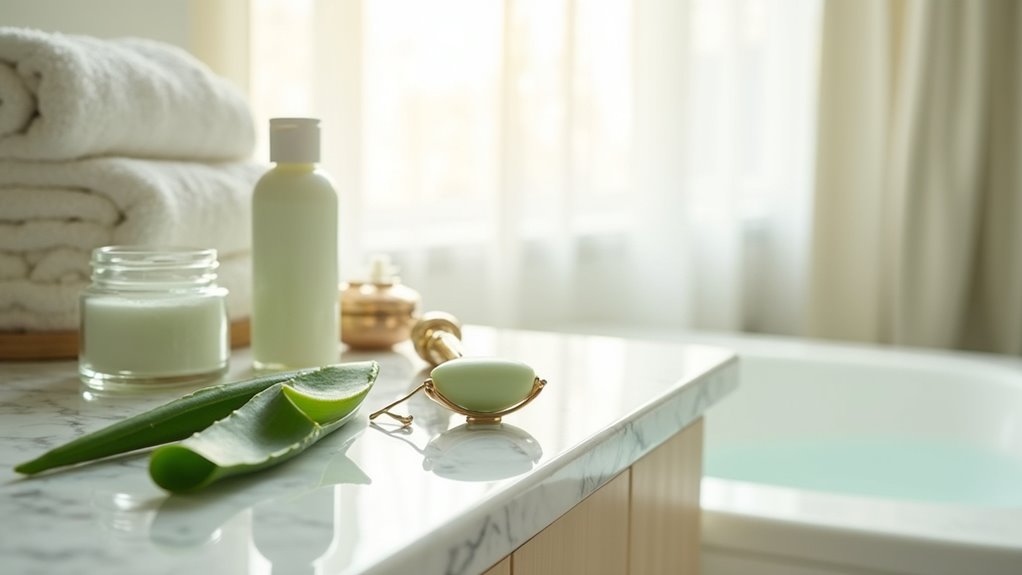
To enhance your skincare routine after removing a pimple patch, focus on gentle cleansing techniques that won’t irritate your skin. Hydration and moisturization are essential, so choose products that nourish without clogging pores. Finally, don’t forget to implement post-treatment protection strategies to shield your skin from UV damage and promote healing. Incorporating products with glycolic acid can also help improve skin texture and prevent future breakouts.
Gentle Cleansing Techniques
While caring for your skin post-pimple patch, adopting gentle cleansing techniques is essential for promoting healing and preventing irritation. Here are four tips to enhance your skincare routine:
- Use a mild, non-comedogenic cleanser that won’t clog your pores, avoiding harsh scrubs that can irritate your skin.
- Incorporate soothing ingredients like aloe vera or tea tree oil in your cleanser to calm any redness or irritation.
- Dab your face dry with a soft towel after cleansing—rubbing can lead to more irritation.
- Apply a calming toner with oil-free balancing properties to restore your skin’s pH balance, setting the stage for better skin health.
Additionally, maintaining a clean environment, similar to how air purifiers enhance performance in improving air quality, can also help in your recovery process.
Being consistent with these gentle cleansing techniques will greatly aid in your recovery process.
Hydration and Moisturization
Hydration plays an essential role in skin recovery after using pimple patches, so it’s important to incorporate both internal and external hydration into your skincare routine.
Start by drinking plenty of water daily to keep your skin hydrated from within. Externally, look for products containing hyaluronic acid, which attracts moisture and keeps your skin plump.
Use a gentle, non-comedogenic moisturizer with ceramides to seal in that hydration and support your skin’s barrier. A soothing toner with aloe vera can help restore pH balance, preparing your skin for better absorption.
Finally, apply a lightweight, oil-free serum post-patch for an added hydration boost. Always monitor your skin’s reaction to new products to guarantee ideal hydration and avoid irritation.
Post-Treatment Protection Strategies
After you’ve used pimple patches, protecting your skin is essential for ideal healing and recovery.
Implement these post-treatment protection strategies to enhance your skincare routine:
- Cleanse gently: Use a mild, non-comedogenic cleanser to avoid irritation.
- Tone: Apply a soothing, oil-free toner to restore your skin’s pH balance and reduce redness.
- Moisturize: Choose a non-comedogenic moisturizer with ceramides or hyaluronic acid to seal in moisture and support recovery.
- Apply broad-spectrum sunscreen: Use sunscreen with SPF 30 or higher daily to shield the treated area from UV exposure, preventing hindered healing and hyperpigmentation.
Additionally, consider using oils like lavender for their soothing properties, which can complement your skincare routine.
Monitor your skin’s reaction to these products, and consult a dermatologist if you notice any adverse effects.
Frequently Asked Questions
What to Do After Taking off Hydrocolloid Patches?
After you take off hydrocolloid patches, start by gently cleansing the area with a mild, non-comedogenic cleanser to prevent irritation.
Next, apply a soothing toner to restore your skin’s pH balance and reduce redness.
Follow that with a non-comedogenic moisturizer rich in hydrating ingredients like ceramides or hyaluronic acid.
Finally, protect your skin by applying a broad-spectrum sunscreen with at least SPF 30, even on cloudy days.
Keep an eye on any irritation.
Are Patches Good for Your Skin?
Yes, pimple patches are good for your skin! They use hydrocolloid material to absorb excess fluid and speed up healing.
Many contain active ingredients like salicylic acid or tea tree oil, which help reduce inflammation and prevent future breakouts. The patches create a moist environment that protects your skin from bacteria.
Plus, they’re non-comedogenic, so they won’t clog your pores or irritate your skin. Overall, they can greatly improve your pimple’s appearance.
How Do You Maintain Your Skin After a Facial?
After a facial, you need to keep your skin clean and dry.
Avoid touching or picking at the treated area to promote healing. Use a gentle, fragrance-free moisturizer with soothing ingredients to maintain hydration.
Don’t forget to apply a broad-spectrum sunscreen daily, reapplying every two hours if you’re outdoors.
It’s best to skip makeup for at least 24-48 hours to let your skin breathe and recover.
Stay hydrated and eat a balanced diet for ideal skin health.
Should I Put My Pimple Patch Before or After Skincare?
You should apply your pimple patch after your skincare routine, but before any moisturizers or heavy products.
Start with a clean, dry face and consider using a soothing toner to balance your skin’s pH.
Once you’ve prepped your skin, place the patch directly on the blemish.
If you’re using it overnight, make sure it’s the last step in your routine to maximize its effectiveness.
Follow the patch instructions for the best results!
Conclusion
Taking care of your skin after a patch treatment is like tending to a delicate garden; it needs attention and care to flourish. By following the right post-patch care steps—protecting from the sun, hydrating properly, and avoiding irritants—you’ll pave the way for a smooth recovery. Keep an eye on your healing process and enhance your skincare routine as needed. Remember, happy skin leads to a happier you, so make it a priority!
